Myobrace® for Adults Stage 2 - A2
Arch expansion and continue habit correction
The A2 focuses on arch development and continuing habit correction. The breathing holes are removed to establish and maintain continuous nasal breathing while the myofunctional features remain present in the appliance to promote correct habits. The firmer polyurethane material puts more force on the anterior teeth to improve their alignment, while promoting arch development at the same time. Move to the A3 when the A2 has corrected the arch form, breathing and myofunctional habits.
Design Features
The design features of the A2 are suited to promote arch development while correcting breathing and myofunctional habits in the permanent dentition.
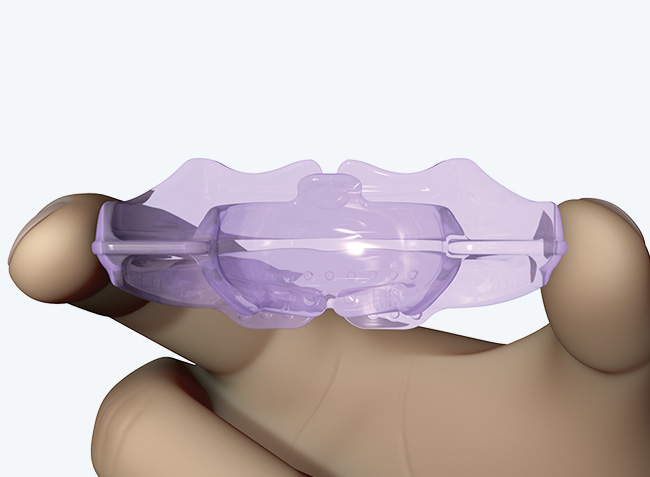
Firmer material
imparts extra force to promote arch development.
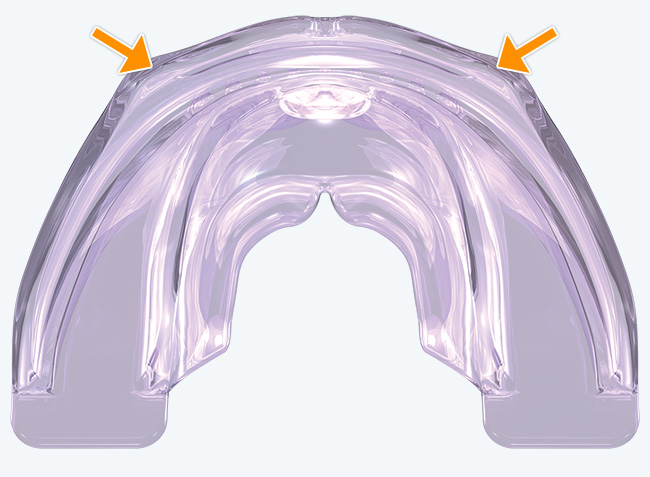
Robust anterior arch form
to impart more force on the anterior teeth for better arch development.

Tooth channels
apply forces to promote dental alignment, especially of the front teeth.
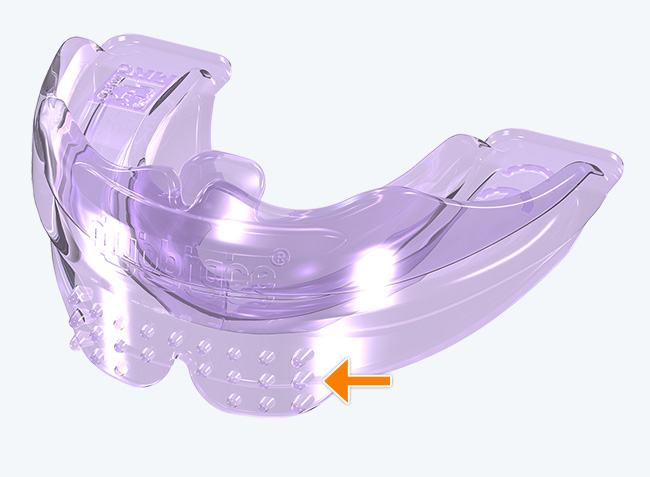
Lip bumper
discourages overactive lip muscles during a reverse swallow.
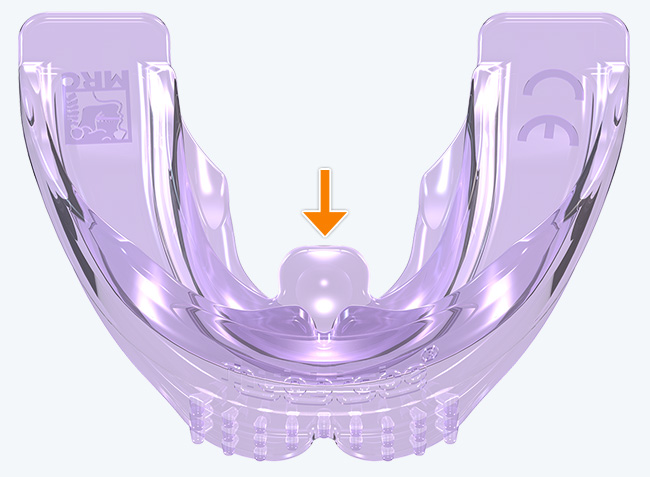
Tongue tag
encourages correct tip of the tongue positioning.
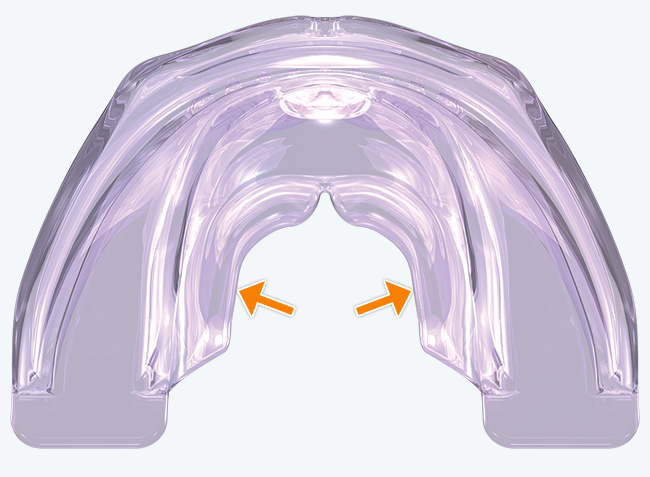
Tongue elevator
encourages the body of the tongue to rest in the roof of the mouth.
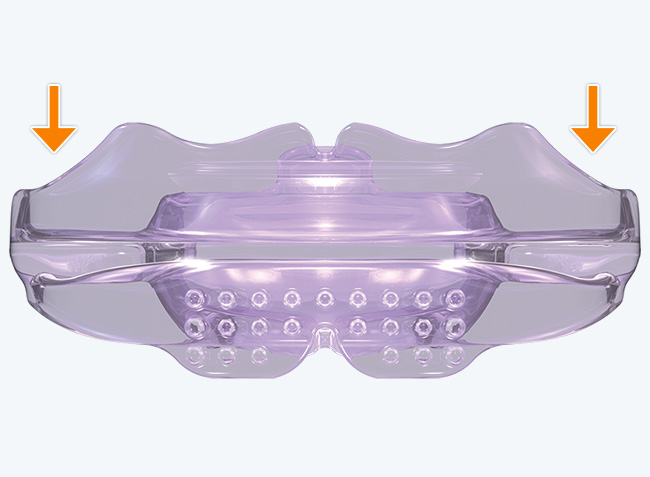
High sides
hold the soft tissues away, promoting arch development while optimising appliance retention.
Directions for Use
The Myobrace® appliance is to be used for one to two hours each day, plus overnight while sleeping. The patient's teeth may become slightly sensitive in the early stages of treatment. This is quite normal, however, if pain becomes excessive, decrease application time with the aim to build it back up once the appliance is accustomed to and sensitivity subsides.
Step 1
Hold the Myobrace® with the tongue tag facing up.
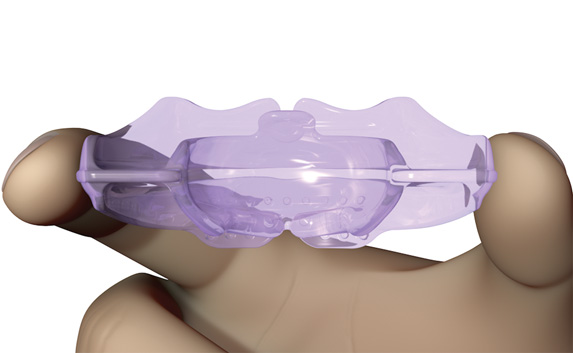
Step 2
Place the Myobrace® into your mouth.
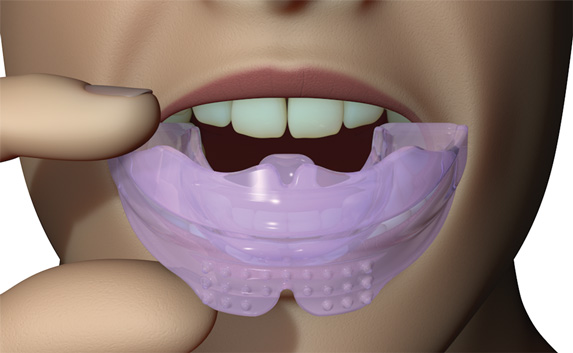
Step 3
Keep your tongue positioned on the tongue tag.
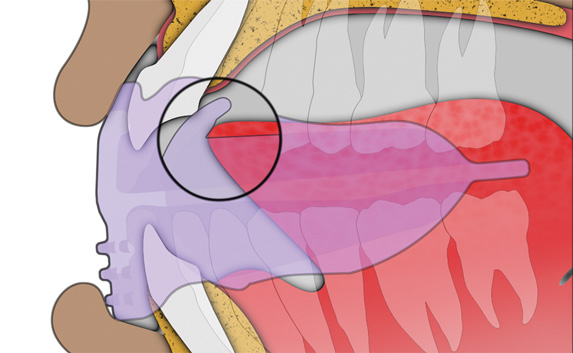
Step 4
Close down on the Myobrace® and feel it working to align your front teeth and jaws.
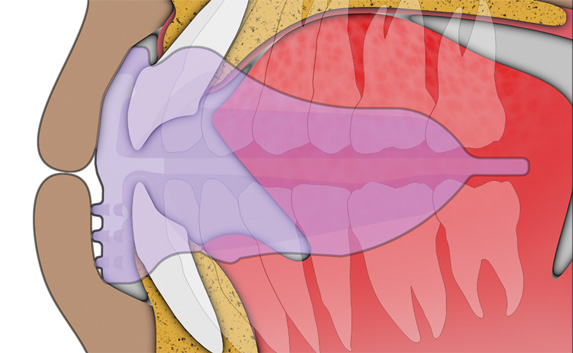
Step 5
Keep your lips together and breathe through your nose.
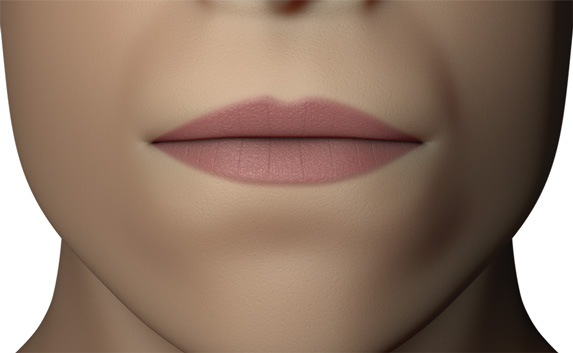
Cleaning the Appliance
The Myobrace® appliance should be cleaned under warm running water every time the patient removes it from their mouth.
Use Myoclean™ tablets to thoroughly clean twice a week. Myoclean™ is the recommended cleaning agent for all MRC appliances.
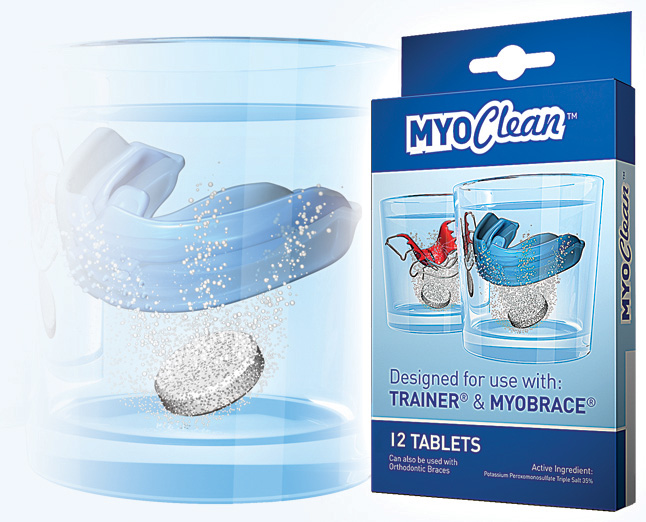
Case Studies
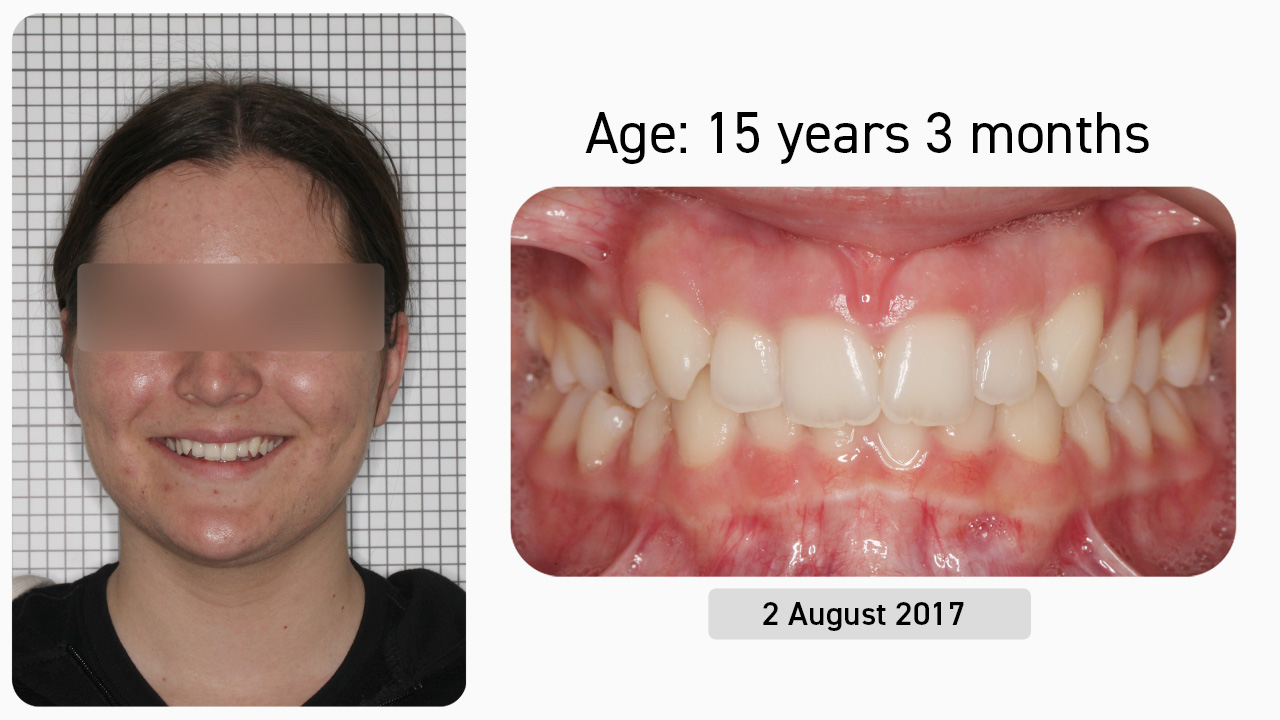
Case Study 1
This 15-year-old female patient presented with the chief complaint of crooked upper front teeth and was seeking a second opinion as she did not want braces. After being presented with the various treatment options, the decision was made to undertake Myobrace® treatment. This involved the use of a series of Myobrace® appliances, in conjunction with the BWS arch expansion appliance and the Myobrace® Activities.
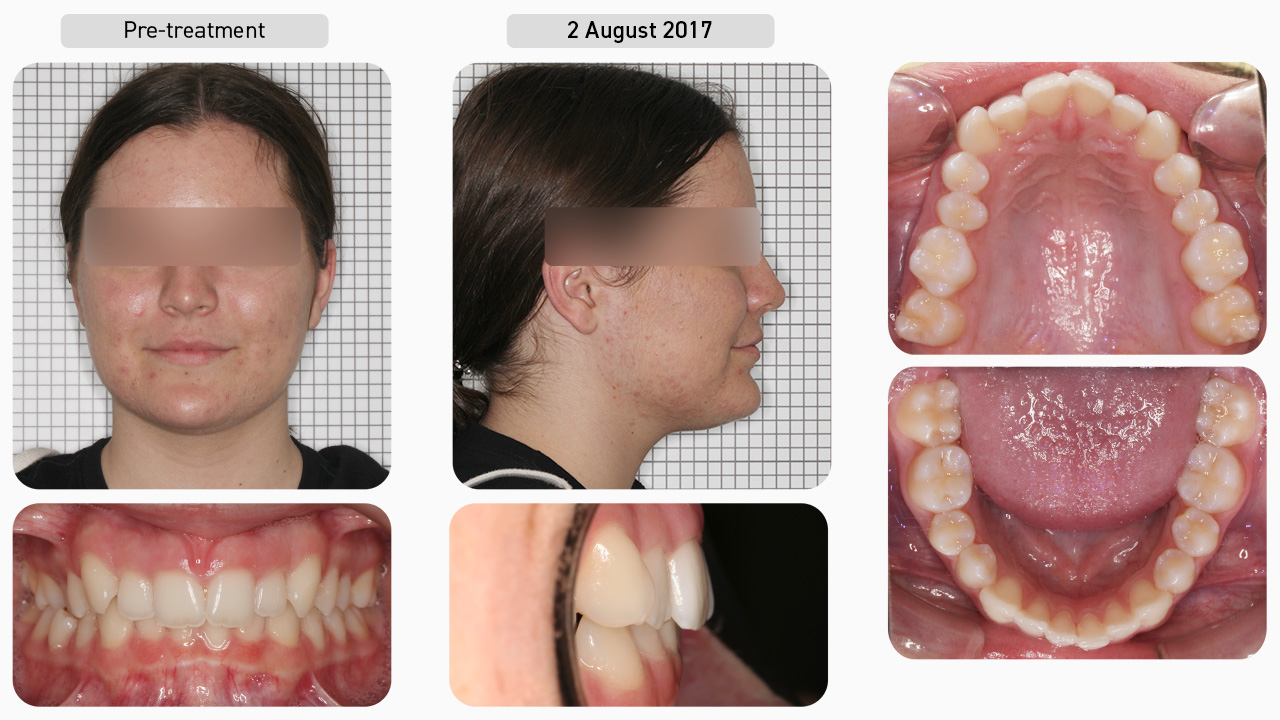
Pre-treatment
Conducting a Myofunctional Orthodontic Evaluation (MOE), we documented that this patient had a deep bite with mild dental crowding. The upper arch was narrow and slightly flattened anteriorly, and the lower arch was also slightly narrow. Her poor myofunctional habits included mouth breathing with low tongue posture and a reverse swallow. Since the patient was in the full permanent dentition, her treatment began with the Myobrace® for Adults series.
Dental Progression
She started with the A1 appliance to establish nasal breathing and begin the correction of myofunctional habits. Once her breathing function had improved, and she was consistently retaining the A1 overnight, she progressed onto the A2 appliance to focus on arch development, dental alignment and continued habit correction. The decision was then made to use the BWS arch expansion appliance to develop the upper arch. The BWS must be combined with a first stage appliance, so the patient was re-issued the A1 during BWS expansion.
Dental Progression
This patient needed multiple rounds of BWS expansion, so the wire was removed for a few months to let the teeth settle, and then re-fit to begin another round of expansion. Once upper arch expansion was complete, the wire was removed once again and the patient was re-issued the A2 appliance, and then the P-3® appliance, both in large sizes.
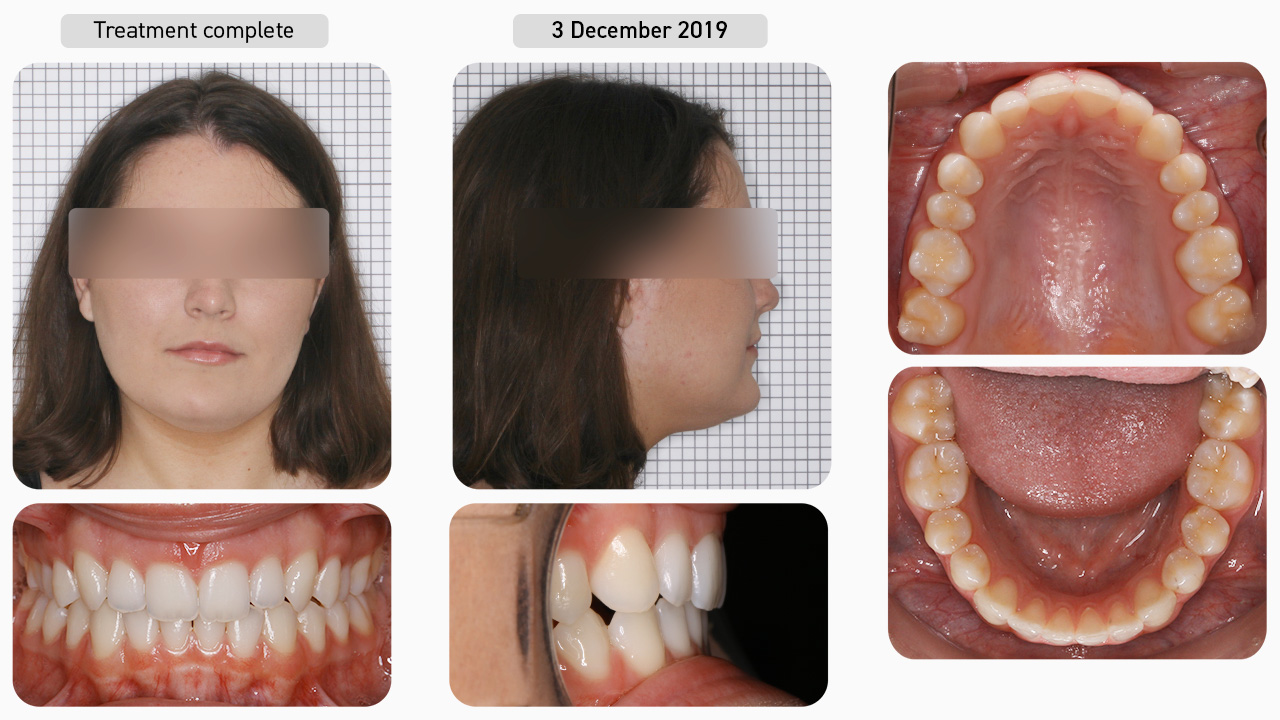
Treatment Complete
Once the goals of Myobrace® treatment had been achieved (correction of breathing and myofunctional habits, arch form and dental alignment), the patient entered into the retention phase. The A3 appliance was issued to retain the arch form, alignment and habits in order to promote good stability of the results achieved.
Facial Progression
In adult patients where growth is complete, we cannot expect to see significant changes in facial development as a result of Myobrace® treatment. However, the patient reports that she is sleeping better, and we can observe that the lips are resting together more comfortably while the labiomental crease has shallowed, all as a result of correcting function. The patient was pleased as the alignment of the upper front teeth had improved without the use of braces, resolving her chief complaint.
Treatment Summary
Using the Myobrace® appliances in conjunction with BWS arch expansion and the Myobrace® Activities, we have helped this patient establish nasal breathing, correct her myofunctional habits and, therefore, achieve natural alignment of the teeth. The arch forms have significantly improved, and the deep bite has resolved. With the correct breathing and muscle habits established, we expect good stability of the result ahead.
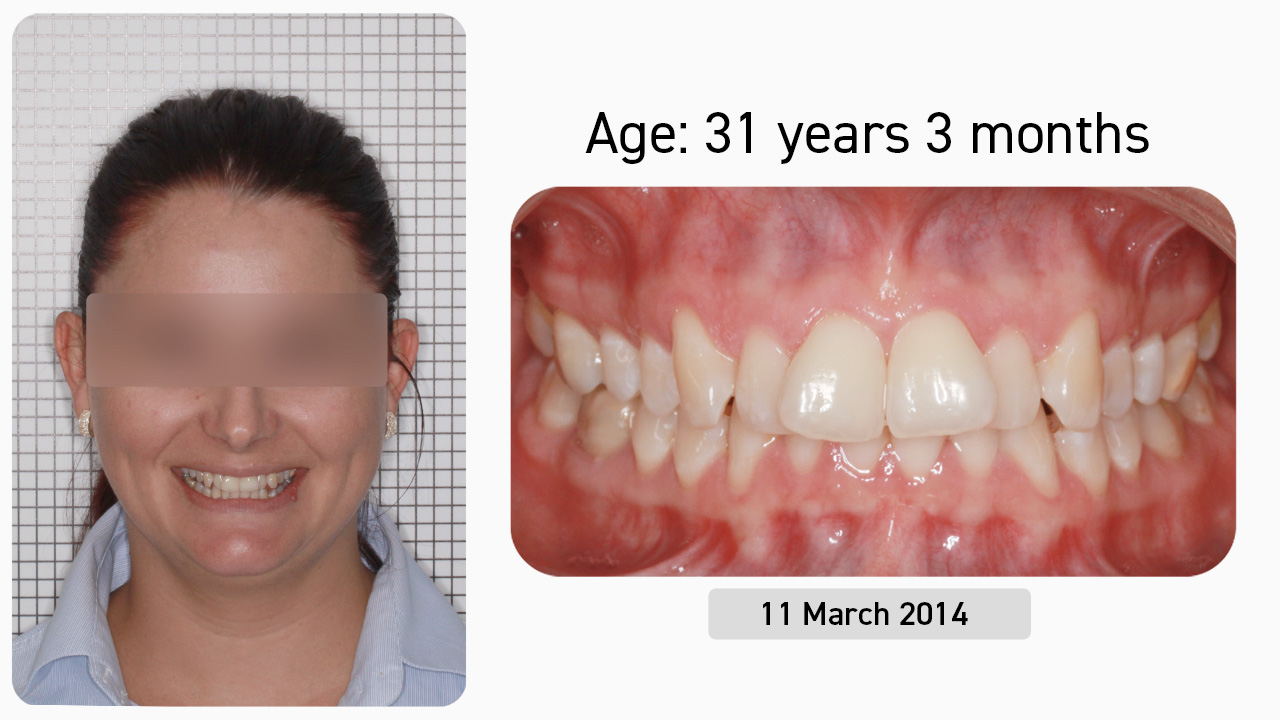
Case Study 2
This 31-year-old female patient presented with the chief complaint of crooked teeth. After being presented with the various treatment options, the decision was made to undertake a two-phase treatment plan. Phase one Myobrace® treatment involved the use of the Myobrace® appliances, combined with the BWS arch expansion appliance along with the Myobrace® Activities to establish nasal breathing, correct the poor myofunctional habits, and develop the arches. Phase two treatment involved the use of fixed braces to finalise dental alignment and occlusion.
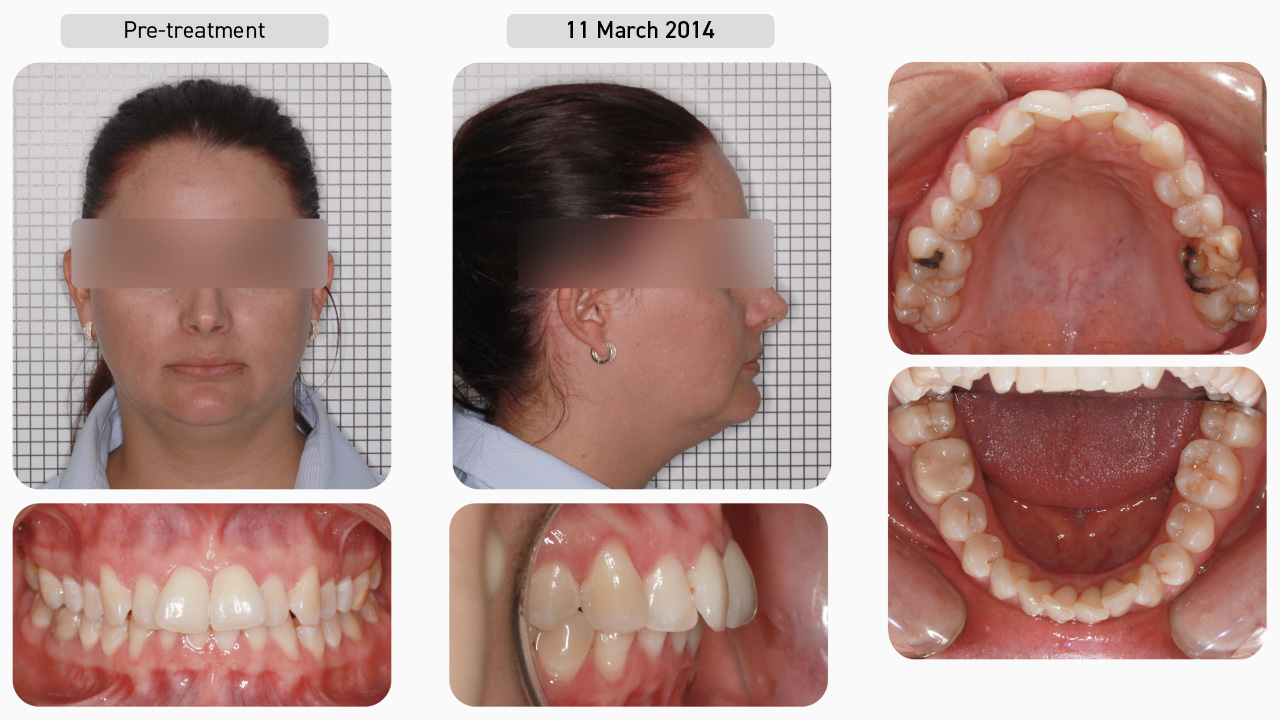
Pre-treatment
Using the Myofunctional Orthodontic Evaluation (MOE) form, we documented that this patient had retruded upper and lower jaws with a deep bite, increased overjet and moderate dental crowding. Both the upper and lower arches were narrow and slightly flattened anteriorly. Her poor myofunctional habits included mouth breathing with low tongue posture and a reverse swallow. Since this was an adult patient, she was treated with the Myobrace® for Adults series.
Dental Progression
She started with the A1 appliance to establish nasal breathing and begin the correction of myofunctional habits. Once her breathing function had improved, and she was consistently retaining the A1 overnight, the patient was ready for BWS expansion. The BWS was used to develop the upper arch form to facilitate correct tongue posture in the roof of the mouth and create space for dental alignment. The BWS must be combined with a first stage appliance, so the patient stayed in the A1. Notice the improved upper arch form following expansion with the BWS. Now there is sufficient space in the roof of the mouth to accommodate the tongue, as well as room for the teeth to align. Once the wire was taken out, she was issued the A2 appliance for further dental alignment, prior to fitting fixed braces. In Myobrace® treatment, we aim to improve the arch forms, occlusion and dental alignment as much as possible before finalising alignment with fixed appliances, as this makes the fixed mechanics much simpler and reduces the amount of time the braces are needed.
Dental Progression
Once the arch forms, occlusion and alignment were as good as could be achieved with Myobrace® treatment, phase two fixed orthodontic treatment began. First, the lower brackets were fit as there was more work required in the lower arch compared to the upper arch. Once the lower teeth were mostly aligned, the upper brackets were fit to perfect the alignment of the upper teeth. Once the alignment had been corrected, the brackets were removed and the patient was issued the A3 appliance for retention.

Treatment Complete
Fixed orthodontic treatment was complete in less than 12 months and no fixed or removable retainers were issued in this case as the patient opted to wear a Myobrace® appliance for retention instead.
Facial Progression
In adult patients where developmental growth has stopped, we cannot expect to see significant changes in facial development as a result of Myobrace® treatment. However, we can appreciate that the lower jaw has translated forward, improving the facial profile. The arches are also wider, resulting in a broad smile with improved incisor display.
Treatment Summary
This adult patient had 12 months of phase one Myobrace® treatment to establish nasal breathing, correct her poor myofunctional habits, and develop the upper and lower arches. This was followed by less than 12 months of phase two fixed orthodontics to finalise dental alignment and occlusion. More than four years after treatment was complete, the result has remained stable without the use of full-time retention.
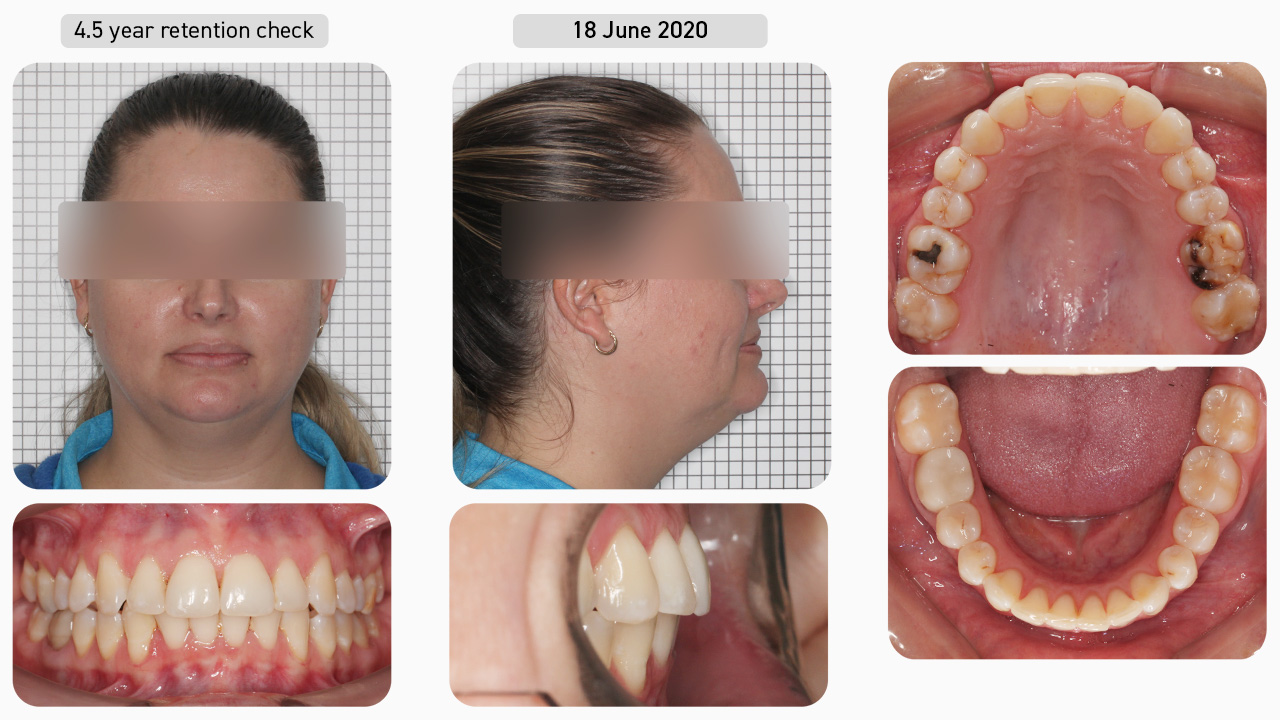
Retention
This patient continued to wear the A3 appliance overnight for retention. Because the breathing and myofunctional habits had been corrected with phase one Myobrace® treatment, the teeth have remained stable without the use of full-time fixed or removable retainers. In fact, she continued to see further improvements even after the braces were removed. For example, the upper arch form has improved and the overjet also continued to reduce during the four years since the braces had been removed.
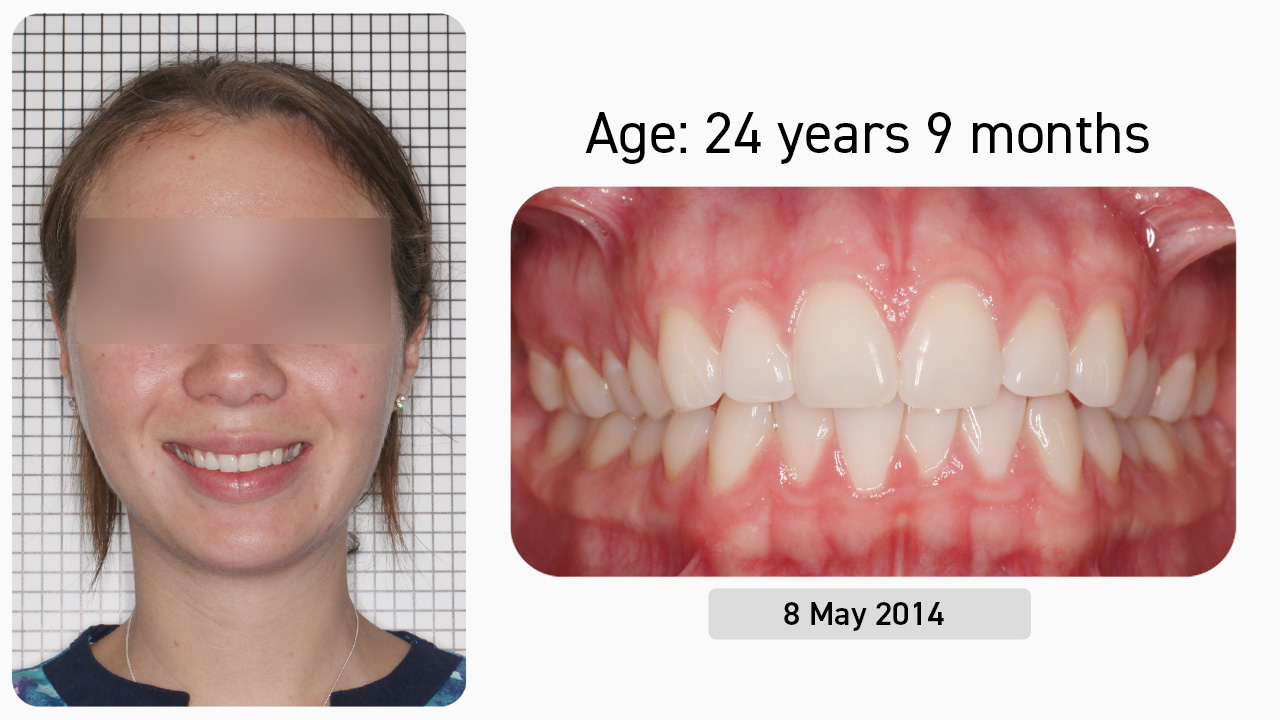
Case Study 3
This 24-year-old female patient presented with the chief complaint of a narrow pinched-in smile and crowded lower front teeth. After being presented with the various treatment options, the decision was made to undertake Myobrace® treatment. This involved the use of a series of Myobrace® appliances, in conjunction with the BWS arch expansion appliance and the Myobrace® Activities.
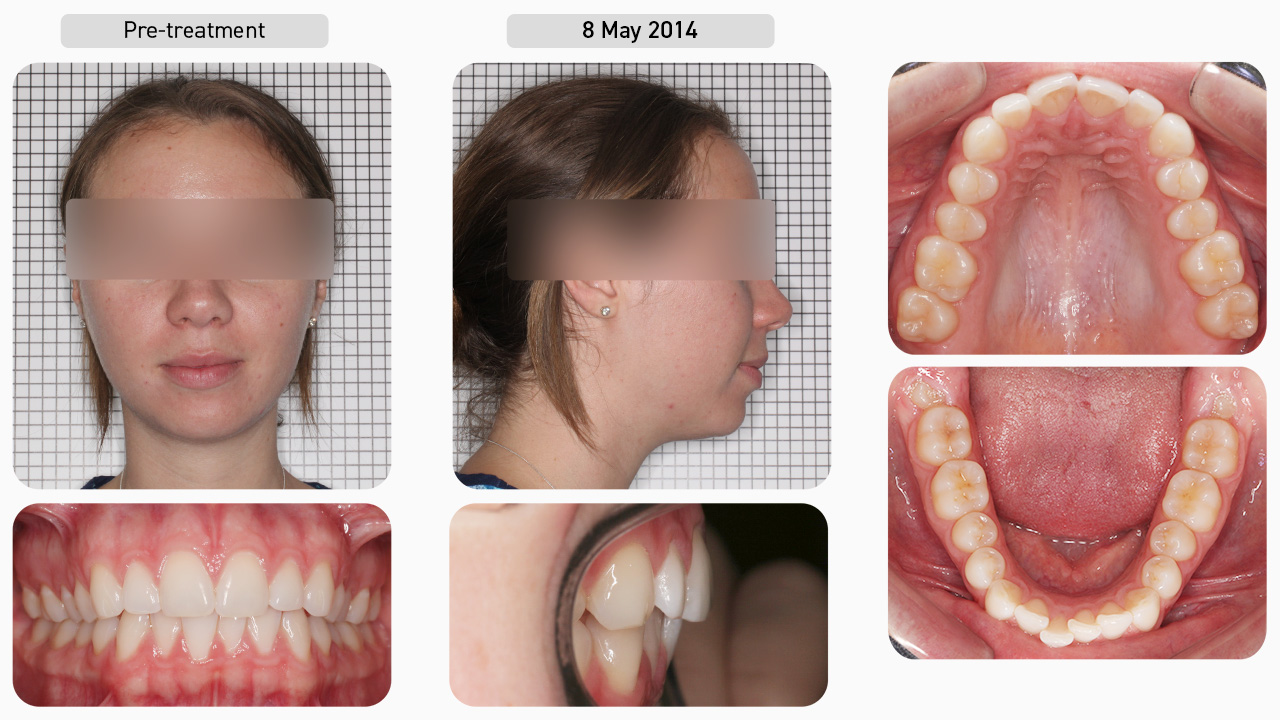
Pre-treatment
Using the Myofunctional Orthodontic Evaluation (MOE) form, we documented that this patient had narrow arches with moderate lower anterior crowding. Her poor habits included mouth breathing with low tongue posture and a reverse swallow. Since this is an adult patient, she was treated using the Myobrace®for Adults series.
Dental Progression
She started with the A1 appliance to establish nasal breathing and begin the correction of myofunctional habits. Just over one month later, her breathing function had improved, and she was consistently retaining the A1 overnight, so she was ready for expansion of the upper arch using the BWS. As the BWS must be combined with a stage one appliance, she remained in the A1. Approximately five months later, BWS expansion was complete, so the wire was removed and the patient was issued the A2 appliance for continued arch development, dental alignment and habit correction. Notice the improvement in lower anterior alignment after only six months of treatment without the use of any fixed appliances in the lower arch.
Dental Progression
Once the alignment, arch forms, occlusion and habits where as good as could be achieved at this age with Myobrace® treatment, the patient was issued the A3 appliance for retention. Note how the dental alignment, arch forms and occlusion have all continued to improve even after active treatment had completed.
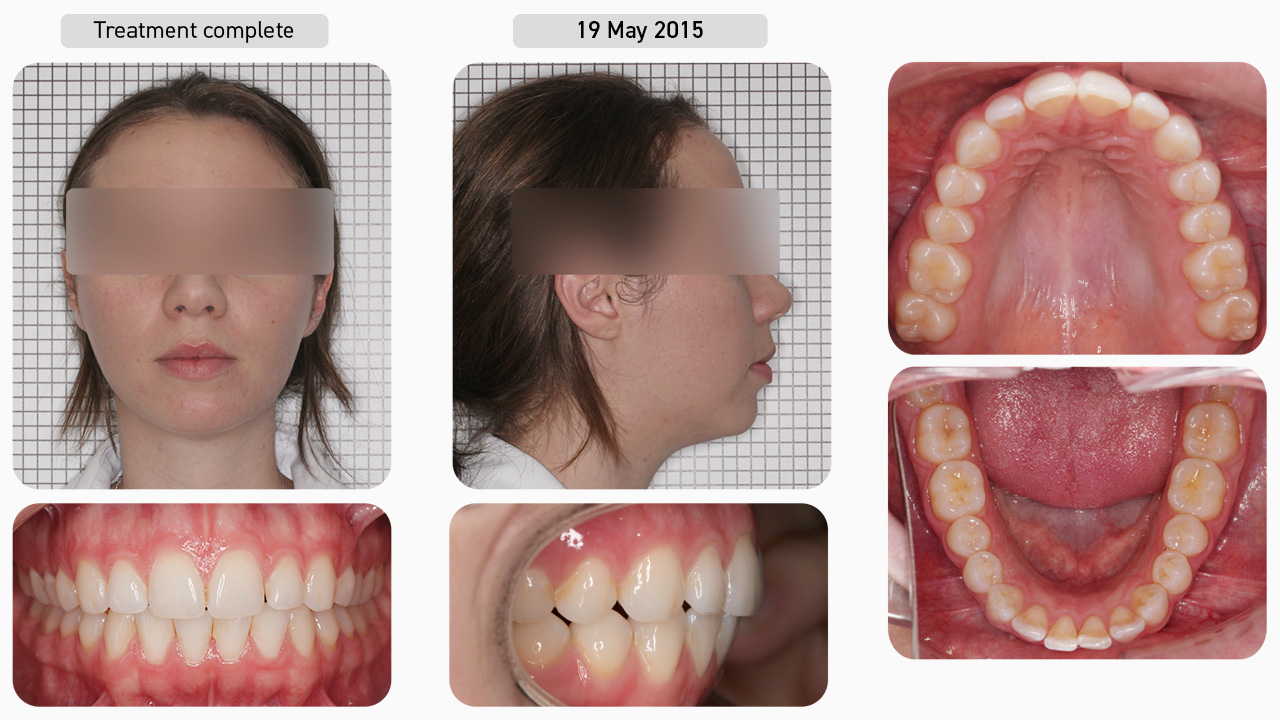
Treatment Complete
This adult patient had only 12 months of active treatment. She then entered the retention phase of treatment, where she continued to wear the A3 appliance overnight to retain the alignment, arch forms and habits to promote good stability of the result achieved.
Facial Progression
In adult patients, where developmental growth is complete, we cannot expect to see significant changes in facial development as a result of Myobrace® treatment. However, we can see that the lower jaw has translated forward, which has positive effects on the airway. The patient reports that she is now exclusively nasal breathing and is pleased with the improvement in her smile.
Treatment Summary
Using the Myobrace® appliances in conjunction with the BWS arch expansion appliance and the Myobrace®Activities, we have helped this patient establish nasal breathing, correct her myofunctional habits and, therefore, achieve natural alignment of the teeth. The arch forms have improved, the lower anterior teeth are well aligned, and the posterior teeth are now more upright.
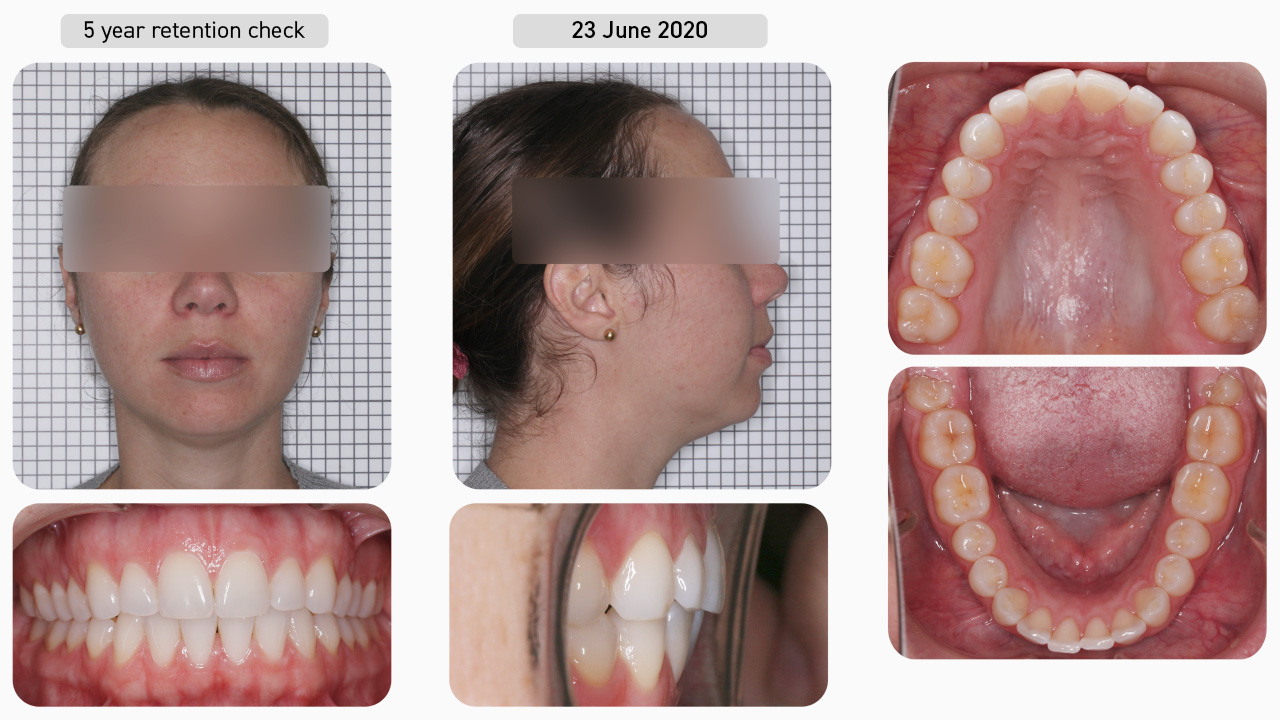
Retention
The patient returned for a retention check appointment more than five years after treatment was complete and you can see that the result has been maintained without the use of any fixed retainers. With the correct breathing and muscle habits continued, we expect this stability to be maintained into the future.
Resources
Appliance Instructions
Downloadable pdf document with instructions specifically for the A2.
Download ResourceMyobrace® Appliance Catalogue
Downloadable pdf document detailing the Myobrace® appliance range.
Download Resource